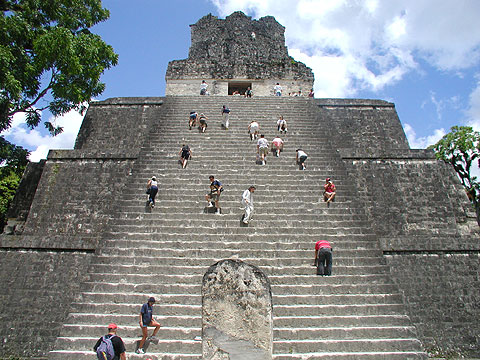The ancient Maya calendar ends Dec. 21, 2012, and Hollywood has wasted no time portraying the coming date as the trigger of a worldwide cataclysm.

Several of Mexico's top tourism officials have been making the rounds in their northern neighbor, betting that an invitation to see Maya ruins will attract hordes of older, wealthier U.S. visitors keen on Mexican culture.
Whereas the Hollywood blockbuster "2012" depicts the end of the Maya calendar as the spark of a global calamity, the Mexican campaign will include a countdown to the calendar's conclusion and urge tourists to visit archaeological sites in the states of Campeche, Chiapas, Yucatan, Quintana Roo and Tabasco.
"Our interpretation of the Mayan calendar is reverse to what many people speculate," Rodolfo Lopez-Negrete, the chief operating officer for the Mexico Tourism Board. "Our focus will be on growth and prosperity instead of the end of the world."
The campaign is the latest effort by Mexico to overcome a steady stream of negative publicity over drug-related violence that has killed tens of thousands and made many American tourists hesitant to venture south of the border.
U.S. travelers made up about 60 percent of Mexico's 22.4 million international visitors in 2010, according to Mexican authorities.
When drug killings first began to dominate headlines in 2008, tourism to Mexico dropped steeply. But it has been rebounding slowly ever since, mostly because of international visitors from countries other than the United States.
From January to May, the number of international visitors to Mexico grew 2.1 percent compared with the same period in 2010, according to the tourism board.
During that time, the numbers of tourists from such countries as Brazil, Russia and China have grown by double digits, the board says. Meanwhile, U.S. tourism to Mexico remained mostly flat, according to the U.S. Department of Commerce.
Tourism analysts partly blame the lackluster travel interest among Americans on warnings by the U.S. State Department. One warning in April said "U.S. citizens have been injured or killed in violent incidents in various parts of the country, especially ... in the northern border region, demonstrating the heightened risk of violence throughout Mexico."
In an effort to deflect attention away from the violence, Mexico's tourism secretary, Gloria Guevara, and the governors of several Mexican states joined the recent swing through the United States to promote their country's historical destinations, particularly 10 Maya archaeological sites in five Mexican states.
But Mexico is still a tough sell among many wary tourists north of the border.
At Montrose Travel in the Los Angeles area, agent sales manager Kate Bernier said U.S. travelers are still reluctant to book flights to Mexican hot spots such as Puerto Vallarta and Mazatlan. "People will still ask, 'Is it safe to go?' " she said, adding that Americans seem less concerned about traveling to Mexican states near the Caribbean, which are home to many of the Maya ruins.
The classic Maya civilization existed from A.D. 250 to A.D. 900, primarily in what is now southern Mexico. It relied on a calendar that began more than 5,000 years ago and runs out Dec. 21, 2012. But most scientists who have studied the Maya calendar say the end only represents the start of a new cycle.
The predictions surrounding the end of the Maya calendar also have been the subject of dozens of books published during the past two years, including the popular "The Source Field Investigations: The Hidden Science and Lost Civilizations Behind the 2012 Prophecies."
Mexican officials say they will promote their new tourism campaign on billboards and in newspaper and magazine ads, targeting affluent travelers interested in Mexican archaeology as opposed to the younger set looking to party and frolic in the sand.
Fernando Ortega Bernes, governor of the southeastern state of Campeche, said he expects the campaign to promote not only Maya ruins in his state, including the ancient city of Calakmul, but also other popular attractions such as hunting, fishing and bird watching.
"This is an opportunity," he said, "to (position) Campeche in the international marketplace."
Author: Hugo Martin | Source: The Seattle Times [September 20, 2011]